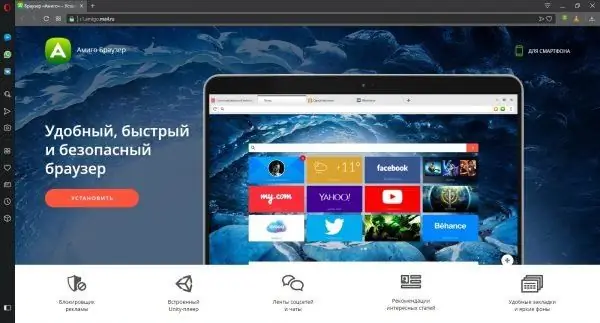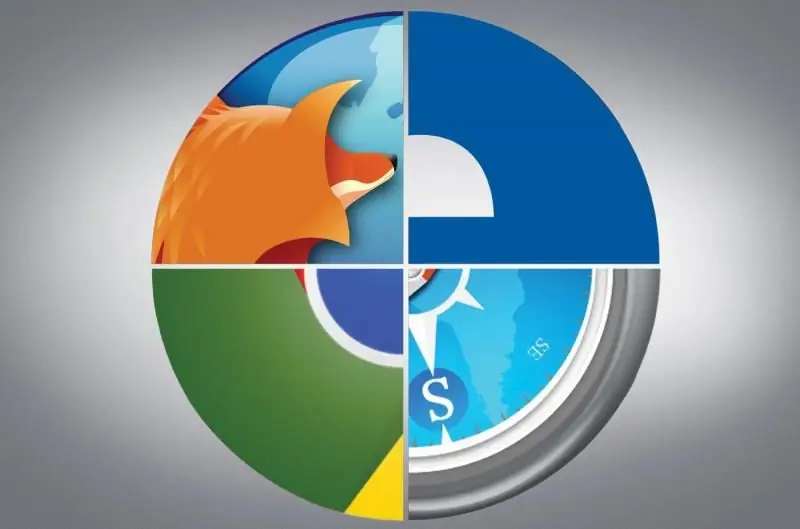
Table of contents:
- Author Bailey Albertson [email protected].
- Public 2023-12-17 12:53.
- Last modified 2025-01-23 12:41.
What you need to know about the Amigo browser

Often, when installing new programs on a computer, we are faced with the fact that in addition to the product we need, suddenly a certain browser developed by Mail.ru - "Amigo" appears. Some users consider it a virus, which, nevertheless, is passed by all anti-virus systems. So what is this browser and should you use it?
Content
-
1 What is the "Amigo" browser
1.1 Advantages and disadvantages of "Amigo"
- 2 Installing the browser "Amigo"
-
3 How to use the browser
- 3.1 Drop-down window "Setting and control"
- 3.2 Browser configuration: basic
-
4 Problems when working with the "Amigo" browser
-
4.1 Browser does not start
4.1.1 Video: how to remove the "Amigo" browser from the computer
- 4.2 Browser won't connect to network
- 4.3 Passwords are not saved
- 4.4 Extensions (plugins) are not installed
-
- 5 How to remove the browser "Amigo"
What is the "Amigo" browser
"Amigo" is a browser that was developed by Mail. Ru for more convenient communication on social networks. It is suitable for operating systems Windows XP / Vista / 7/8 / 8.1 / 10, and there is also a mobile version of the application.
Like other well-known browsers (Google Chrome, Yandex Browser and others), Amigo was created primarily to promote the products of the developer company: a search engine, mail agent, games, maps, social networks and so on. … That is why it is installed automatically together with other Mail Group products (and not only with them). That is, "Amigo" is not a virus at all, but just an element of an advertising campaign, nothing more.
A feature of the "Amigo" browser is the function of monitoring the feed of the social network. On the right side of its window, a news feed of the social network you have selected is shown in a vertical frame. At the same time, switching between networks takes place in one click, which, of course, is very convenient. All news from groups and friends are displayed, but there is no automatic update, which is convenient for those who have many different subscriptions.

The most popular social networks in Russia are integrated with Amigo
The browser allows you to listen to music and sort it by album without logging into a social network. With one click, you can transfer all bookmarks from other web browsers to it, if necessary. There is a small icon in the address bar: when you click on it in the selected social network, a link is saved on your wall, by which you can enter Amigo.
Advantages and disadvantages of "Amigo"
Amigo has a number of advantages over other browsers:
- performance: the speed of the browser is affected by various extensions and plugins, which are inactive by default and do not overload the browser platform;
- any extension from the Chrome store can be installed in Amigo;
- simple interface;
- Mail.ru Checker button: when you click on it, Mail.ru mail opens, which is convenient for those who use this mail ;
- resource intensity: "Amigo" uses RAM very moderately, so it can work even on weak machines.
Like any product, Amigo has its drawbacks, in particular:
- only the most popular social networks are available for connection (Odnoklassniki, Moy Mir, Vkontakte, Facebook, Twitter, Google+, Mamba);
- cannot connect ICQ, Skype, Google Talk, Windows Live, AOL, Yahoo.
Installing the browser "Amigo"
The Amigo browser is free and often installed automatically along with other programs. The system requirements are:
- Windows XP or higher;
- Intel Pentium 4 processor and later;
- at least 2 GB of RAM;
- at least 5 GB of free disk space.
If you set out to download the browser, then you need to follow the official link and click the "install" button. To use Amigo, no registration is required either before installation or after, which greatly simplifies the work with it.

Click the "install" button
Then follow these steps:
-
In the window that opens, select the folder where to download the installation file and click the "Save" button. The browser will download in a few seconds.

Window for saving the downloaded installation file Click the "Save" button
-
Go to the folder where you downloaded the amigo_setup.exe installation file and run it.

Start of installation of "Amigo" Run amigo_setup.exe to install the browser
-
After a while, a window will open with a message stating that the Amigo is almost ready to go. Click "Next".

Window with a message that the browser is almost ready to work Click "Next" to complete the installation
-
Wait a little more until the installation is complete and the browser will automatically open.

Browser Settings Home Page After opening the initial browser page, you can start configuring it
-
Now you need to install all the components that will facilitate your work with social networks. To do this, click on the "Continue" button on the home page (or the "Set as default" button if you want to make Amigo your main browser). You will be prompted to install a button for quick access to Mail.ru mail.

Installing a button for working with mail After installing the mail access button, Mail.ru mailbox will become available in one click
-
At the last step, you will be prompted to install a button for listening to music.

A window prompting you to set up quick access to music When you click on this button, you will immediately go to the folder with music files
-
After completing all these steps, the main browser window will open. This completes the installation and you can use the browser.

Main browser window "Amigo" After the main window appears, the "Amigo" browser is ready to work
How to use the browser
Since the "Amigo" browser is primarily intended for users of social networks, we will consider the main components of its interface that facilitate the use of these services.
-
If, when setting up your browser, you installed a mail access button, then it will appear on your quick access panel. To open the mail, you just need to click on the icon,.

Mail window To enter mail, click the blue button on the quick access bar
-
The button for listening to music works in the same way, if you have installed it.

Music window Click on the notes icon on the Quick Access Toolbar
-
In the browser itself, there are five buttons in the upper right corner. Let's start with the rightmost one - it is responsible for browser settings. When you click on it, a drop-down panel "Settings and Management" appears, the actions with which will be discussed in detail below.

Drop-down settings and control panel Click on the button on the far right, select the required parameter in the drop-down panel and make the necessary settings
-
To the left is a green button that shows the news feed.

Opening a panel with a news feed Click on the green button and select the social network whose news you are interested in
-
In the panel that opens, you can switch between different social networks using the icons at the top of the panel.

Switching between social networks in the panel Select the desired social network using the logos at the top of the panel
-
There is also a button with three vertical dots in the right corner of the news feed panel, which is responsible for setting up quick access to social networks. By clicking on the square with the logo, you can disconnect or connect the corresponding network on the panel.

Customizing the News Feed Panel Select the networks you intend to use
-
To the left of the green news feed button is an orange button, which is responsible for chat on various social networks.

Social media chat panel Select the social network in which you are going to chat
-
Further left is a gray button that opens mail. By clicking on it, you can select the desired mailbox in the panel that appears on the left. This will not close the social media panel for your convenience.

Mail login window Choose the mail system you need
-
And the last button is in the form of an asterisk: it is responsible for adding a page to bookmarks so that you can always quickly open it. Click this button, it will turn yellow. After that, choose where to save the bookmark, give it a name if you want, and click the "Finish" button.

Bookmarking a page Save the pages you want to bookmark bar
Drop-down window "Settings and control"
This window needs to be considered in more detail, because this is where all the options that provide comfortable work with the Amigo browser are contained. Namely:
- scale - if necessary, you can change it using the "+" and "-" buttons;
- entering full-screen mode (the button in the form of frames to the right of the scale) switches the browser window to such a mode when there is no quick access panel; to exit this mode press the F11 key;
- you can open a new window by clicking on the "New window" line or by pressing Ctrl + N;
- the "Incognito Mode" function allows you not to save information about your actions on the network in the browser, that is, the addresses of the web pages you visit will not be stored in the browser history, and the list of downloaded files will not be shown in the "Downloads";
- the "Night / Day Mode" function changes the color of the tab bar from white to dark and vice versa;
- the "History" function opens a log of the web pages you have visited, if incognito mode is not set; for each page, the address, date and exact time of visit are indicated;
- the "Downloads" function opens a list of all your uploaded files in a new tab; here you can get information when, where and which file was downloaded, in which folder it was saved, and also whether it still exists on the computer; this is very convenient if you did not pay attention to where you saved the file, or accidentally deleted it from your computer;
- the "Bookmarks" function opens a drop-down list of possible actions with bookmarks: creating new ones, a list of folders where bookmarks are stored, and more;
- the "Settings" function is intended to go to the browser settings window;
- the "Advanced" function - what you can do with a specific web page is listed here: find some piece of text, print the page, view the code, and so on.
Browser setting: basic
In order to change the browser settings, click the rightmost button opposite the address bar (with an icon in the form of a vertical ellipsis), open the "Settings and Control" panel and go to "Settings". A new tab will open, where you can change the basic settings, and if necessary, go down to the bottom of the page and click the "Advanced" button, thereby opening a set of additional options. There you can change the browser language and customize its interface to your liking.

To open more settings, click the "Advanced" button
Problems when working with the "Amigo" browser
Problems can sometimes arise when using the browser. Let's consider the most common of them and how to eliminate them.
Browser won't start
The browser may not start for only two reasons:
- application files were damaged;
- there are not enough computer resources, such as RAM or disk space.
In the first case, you need to uninstall the browser and reinstall it. In the second, you should wait until the resource-intensive processes, usually associated with the processing of photos, videos and music, are completed. If this does not help, then reinstall your browser.
Video: how to remove the Amigo browser from your computer
Browser won't connect to the network
This is not a problem with the browser, but with the computer. Check your internet connection on other devices (smartphones, tablets, etc.), and if everything works fine there, restart your computer. If the Internet is not available on any device - contact your provider.
Passwords are not saved
Open your browser settings and check how the password saving is configured:
-
For quick access, use the button located next to the "Settings" label.

Main menu button in the settings window Click on the main menu button for easy search of the desired settings section
-
The main settings menu will open, in which all settings are divided into sections. Click "Advanced" to expand the entire list of sections. Next, select the "Passwords and Forms" section.

Main settings menu Select the section "Passwords and Forms"
-
There are only two items in this section. Select "Configure" to configure how passwords are saved.

Section "Passwords and Forms" Select "Customize"
-
Check if password saving is enabled. On the left should be written "ON" and the button should be blue. If you want the browser not to save passwords, click on this button - it will turn gray.

Password saving settings "ON" and the blue button indicate that the browser is saving passwords
Extensions (plugins) are not installed
If the extensions are not installed, then you need to clear the cookies and try to configure the browser again. For this:
-
Go to your browser settings, click "Advanced" and find the "Privacy and Security" section.

Tab with settings "Amigo" Find the section "Privacy & Security"
-
Click "Clear history" and in the window that opens in the list "Delete the following items" select the line "for all time".

Browser history clearing window For complete cleaning, select the "all time" option
- Select additional items that you want to remove, but leave the default ones selected. After that, click the "Clear history" button and try to install the extension again.
How to remove the browser "Amigo"
The Amigo browser is uninstalled in the same way as any other program:
-
Click on the "Start" button (lower left corner of the screen) and type "Control Panel" in the search bar. Open this window.

Windows Control Panel Window Find the section "Programs"
-
Select the "Programs" or "Programs and Features" section (names may differ in different OS versions). Here you will see a list of all programs installed on your computer. They are sorted in alphabetical order (first English names, then Russian).

List of installed programs Find the application "Amigo" in the list
-
Find the program "Amigo" and double-click on it. After a few seconds, a window will appear with information about removing the program. You will be prompted to delete all information about the program's operation - check the box so as not to clog your computer.

Removing a program Check the box to delete all browser data along with the program
-
Click the "Delete" button and wait a while.

The changed window with the list of programs Browser "Amigo" removed
After uninstalling, residual browser files may remain on disk, but I do not recommend uninstalling the browser completely, that is, via the command line. The fact is that most users do not fully understand how to use this, and can delete something important, which will disrupt the work of other processes. The removal described above is quite sufficient, but after it the browser can recover again at the earliest opportunity.
Browser "Amigo" is convenient for those users who use the Internet mainly for communication in popular social networks. Installing it is quite simple, there are no difficulties when using it. There are applications that can be installed on a computer, but cannot be removed; fortunately, Amigo is not one of those.
Recommended:
How To Completely Remove The Amigo Browser From Your Computer - Instructions And Tips With Photos And Videos

Stages of removing explicit and hidden files of the Amigo browser, including from processes and startup. What to do if the browser is installed again after uninstallation
How To Update The Browser On A Computer, Laptop, Phone For Free - Step-by-step Instructions And Descriptions Of Different Methods

What browsers are used for and why it is important to update them regularly. How to update the browser manually on a computer, tablet and phone
Free VPN Extension For Opera: What It Is, How To Download, Install On A Computer, Enable And Configure For Opera

What VPN services exist in the form of extensions. Is there a built-in VPN in Opera. How to install VPN extension in Opera browser and use it
Free VPN Extension For Yandex Browser: What Is It, How To Download, Install On A Computer, Enable And Configure For Yandex

What is VPN. VPN extensions for Yandex Browser: search, installation, configuration. Description of popular VPN extensions
Free VPN Extension For Mozilla Firefox: What It Is, How To Download A Plugin, Install It On A Computer, Enable And Configure

What is a VPN extension. What VPN add-ons can be installed on Mozilla Firefox. How to use them: enable, configure settings
